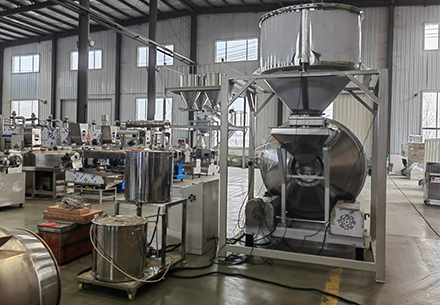


The coating process for pet food is primarily used in dry food products. Dogs use their sense of smell to pick up food, while cats use their tongues to taste and select food. Therefore, it is crucial for pets to directly perceive the flavor and aroma of the ingredients. Therefore, powdered or paste-like flavor enhancers and oils are sprayed on the surface of dry food pellets to enhance their appeal.
Key Points Affecting Coating Results
1. Uniform Coating
The goal of uniform coating of dry food is to ensure that pets can easily and maximize the aroma and delicious taste.
a. Pets can sense whether pellets are evenly coated. For example, cats will turn their noses up at unevenly coated pellets. Increased uniformity in coating increases pet palatability.
b. Each step in the coating process ensures that the flavor enhancer is evenly distributed, maximizing its proximity to the noses and taste buds of cats and dogs, thereby maximizing its delicious effect.
2. Correct Coating Order
The order in which the oil and flavor enhancer are applied directly affects palatability.
a. Avoid encapsulating the flavor enhancer with fat. Ensure the flavor enhancer is fully exposed on the particle surface to maximize its effectiveness.
b. The spraying time determines the degree of bonding and even distribution of the fat and flavor enhancer on the particle surface. Generally, each spraying cycle lasts approximately 30 to 90 seconds.
c. The spraying order is grease, slurry, and powder. Applying the slurry first and then the fat, or a mixture of slurry and fat, will clog the particle pores, preventing the fat from penetrating the particles.
d. Allow sufficient time (30 to 60 seconds) for each component to fully bond to the particle surface before spraying the next component.
3. Use the Right Equipment
Spraying equipment has evolved over time, from initial atmospheric pressure spraying to current vacuum spraying. Atmospheric pressure spraying is categorized into batch and continuous spraying depending on process requirements. Vacuum spraying primarily involves batch spraying, evolving from initial vertical vacuum spraying to current horizontal vacuum spraying. These systems feature larger access doors, allowing for comprehensive cleaning and better compliance with food hygiene standards.
Pet food equipment has higher requirements than feed equipment, particularly regarding hygiene. The post-expansion section and the parts that come into contact with the product are constructed of stainless steel. Equipment design is designed to eliminate residue, ensure easy cleaning, and prevent Salmonella contamination, thus meeting food hygiene standards. Spraying oils and flavorings enhances the nutritional value of pellets, creates a smoother and more attractive appearance, and makes the product more competitive in the market. To achieve optimal palatability within budget, precise dosage of oil, liquid, and powder is required, making the right equipment crucial.
4. Effective Spraying
Effective spraying is the key to success. Grease, slurry, and powder coatings should be applied over a wide area over the particles for a sufficient duration to ensure direct contact with a sufficient number of particles.
a. For grease and slurry spraying, select the correct nozzle for uniform spraying. Alternatively, use nozzles of varying capacities separated by pneumatic valves, allowing for flexible switching based on flow requirements. Finally, ensure proper nozzle positioning to ensure precise alignment of the spray particles during operation.
b. Powder spraying process: Optimization can be achieved using distributors. For example, a vibrating separator can ensure a wide, continuous, and consistent powder spray coverage, ensuring direct contact with the maximum number of particles possible.
c. To ensure consistent application, it is recommended to spray grease and slurry over a wide area for approximately 60 seconds.
d. For grease and slurry spraying, use nozzles of varying sizes separated by valves to facilitate control of flow rate and spray pattern. For powder spraying, use a vibrating distributor to control the spraying process, ensuring a constant, uninterrupted flow rate.
5. Stir
Both stirring time and intensity are crucial to ensure that the oils and flavor enhancers are thoroughly coated and distributed across the entire surface of each particle. Stirring too quickly will result in uneven coating of the particles. Stirring too vigorously can damage the particles or cause them to break apart.
a. Stir for at least 45 to 60 seconds after each spraying step to ensure that the ingredients are thoroughly coated.
b. Control the stirring intensity to avoid particle breakage and dust generation.